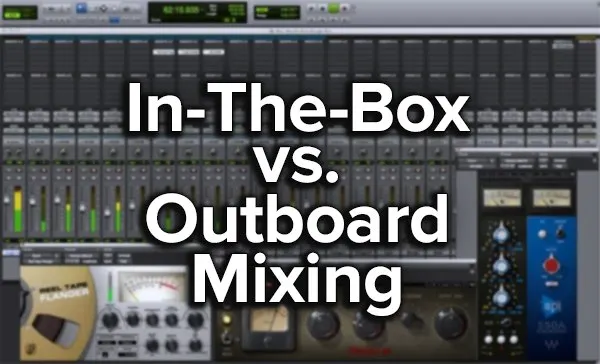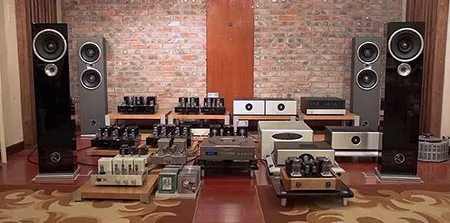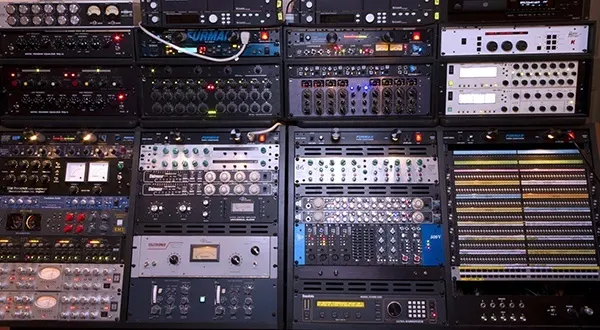A lot of us take the art and science of mixing and mastering music very seriously. Most of us focus on one thing: the quality of the outcome, not mixing in the box or out of it. Who cares how you do it as long as the end result rocks, right?
NOPE.
People like drama. People like to be different and unique. People also experience confirmation biases, placebo effects, and flat out just have passionate preferences. It’s these folks that are carrying on an eternal debate within the studio engineering community.

Let me explain the debate and then I’ll be the voice of reason and wisdom (which will go unheard, because some people don’t argue to find an answer, they argue for the sake of arguing).
Should I Mix In-The-Box or with Outboard Studio Gear?
Question:
Hey LN team, is there really a difference between mixing with plugins versus doing it all with hardware? People on forums swear their hardware sounds better, but shouldn’t digital technology have less noise and at least equal results in terms of quality?
What’s your opinion on mixing in the box?
Jake O.
Answer:
This is the question that sparks the controversy every time. If you’re reading this you might already be aware of both sides of the argument, but if not let me summarize it real quick:
Mixing In The Box: Cheaper, Faster, Same Results
Outboard Studio Gear: Infinitely Better Results
The above is not true, at all. The basic question is whether or not we should accept mixing in the box with digital plugins inside of a computer or if we need to be routing analog signals all around the studio through tons of machinery to get better results.
The Perpetuation of Mixing Silliness
Here’s what people claim. No amount of double blind scientific experiments will get people to change their mind. No amount of exposing their own psychological flaws will change them. They know these things to be true. These folks exist in every industry and are basically suckers for marketing. Who are they?
- They are the kind of people who claim they can hear the difference in their audiophile set-up between a $50 XLR cable and a $10,000 XLR cable, even though they are quantitatively the exact same cable minus the price.
- They are the kind of people who claim that they can only use Duracell batteries in their overdrive pedals because Energizer doesn’t sound right.
- These are the folks who will spend $20,000 on a turntable needle to listen to music in their room that features zero acoustic treatment.
None of this is an exaggeration.

However, it’s an overkill in terms of this conversation, but I mentioned it because this same type of thinking exists in a lot of the out-of-the-box mixers.
But is it the truth?
No, here’s the real deal that nobody is saying out loud. They are hiding their true intentions and motivations for saying a lot of these things…
The Truth of the Matter
There’s one reason people who prefer mixing with external studio hardware claim for their ferocious opinion on the matter: “It sounds better.”
There’s for real reasons for them saying this, and they are:
- They are old timers and it’s what they’re used to.
- It takes skill and a LOT of money, which blocks out competitors
- It feels and looks 100x cooler to their clients (marketing matters!)
- If it’s not true then they’ve wasted a whole ton of money and emotional investment.
That’s the real deal.
Now check this out. I think the entire argument is stupid and will explain why in a second. I’m in agreement with the guys who prefer In-The-Box mixing. With that being said, I prefer outboard mixing! I have a lust for more gear.
I love tinkering, collecting, testing, and just playing around with it all. It’s not a big deal. I think it looks awesome and I love it when folks walk into my studio and get their mind blown from all the hardware with crazy knobs and blinking lights. It makes me feel special, talented, etc.
Why Mixing In The Box is the Future (& Present)
Anything and everything being done in the analogue realm in terms of compression, equalization, reverb, delays, etc… all of those effects have been perfectly emulated in the digital realm. But there’s several huge advantages to mixing with plugins inside of a digital audio workstation.
Lack of Electrical Interference
When you keep passing an analog signal through a ton of cables and instruments, its picking up electrical interference. It’s an electrical signal that can be altered by other electrical signals. Sure, our cables shield from a lot of it, but the longer that signal exists out of the box the more susceptible it is to these problems.
When you get your signal into the computer and keep it there, you’re now messing with binary code that can’t be destructively altered in any similar way. (Of course, unless you save over your file or don’t take backups and the file becomes corrupted, but that’s besides the point.)
Perfect Emulation of Analog Saturation
“Yeah but you don’t get that analog warmth!” Except you can. When plugin developers saw this part of the argument rising, they realized that a lot of it was legit. You can listen to old records and hear the pleasant saturation of tapes and transformers and vacuum tubes.
This is just harmonic distortion. The developers wrote algorithms to not only supply you with the same saturation, but with variable controls so you can choose exactly how much and where. That’s far better than having one setting that you can’t control, minus an impedance switch here and there.
Absolute Recall of Settings
Back in the day, studio engineers had to have assistants who would run around with sheets of paper with knobs drawn on them and mark down the position of each knob, fader, etc. It was absurd if you didn’t finish the mix in one sitting.
And if you committed it to tape and the client wanted a change, well guess what? If you wanted to make dynamic changes to volume throughout a song, you had to ride the fader with your hand and nail that performance live too.
Nowadays, everything is digital. You can save your settings. You can draw in automation lines for your “fader rides” digitally with perfect recall every single time. You can copy, paste, undo, redo, save projects, reload them the next day in 3 seconds…
Considering the perfect software emulation of hardware, why would you not take advantage of this feature? Especially when clients are going to ask for very minute and detailed changes several times over.
Plugins and DAWs are Cheap
There’s some hardware you can’t go without. You can’t record sounds without a microphone, and you can’t boost that mic-level signal to line-level cleanly without an awesome preamp.
Beyond that… why pay $4,000 for a single channel 8-band hardware equalizer when you can pay $100 for a 16-band or parametric equalizer plugin that can be slapped on as many channels as you’d like at one time? Consider that it’s the same company selling you the software version of their hardware EQ… It’s pretty much the exact same thing.
The Only Benefit to Outboard Mixing
Here’s what I think is the main benefit to mixing outside of software. Besides the marketing and visual aspect, and the fun of routing signals and summing together externally, and everything else we mentioned above…

The main benefit is psychological. You have to dial in your settings, tweak it, get it right, and commit to it. You don’t get to play the game of doubt and return to the mix 30 times over the next week until it’s not recognizable any more. You learn to trust your ears, use them while they are fresh, make the final call, and accept it. That’s if you’re ballsy and ready to walk the razor’s edge.
Otherwise, you can mix stems of just drums, just guitars, just vocals. Even then though, you’re going to waste a lot of time double guessing yourself. The psychological benefit builds confidence and helps you increase the amount of work you’re pumping out, which means more money for you in the end.
The Mixing Middle Ground
Here’s what I think the solution should be. There are three options:
- Mix Entirely In-The-Box
- Mix Entirely Outboard
- Combine the Two
It’s not a binary situation. You can have the best of both worlds, which is what I prefer. I honestly can’t afford 16 channels of everything from compressors, EQ’s, effects processors, converters, patchbays, cables, preamps, and a summing box. I use what I have though in a way that keeps my workflow fast and efficient but gets my rocks off because I get to play around with these awesome pieces of gear.
The best advice for any newbie is to record absolutely dry signals. But if you’re not a complete newb then you can commit some effects to the take before it ever hits the DAW. I always include a little compression and EQ on the way in.
A lot of times I’ll go all the way with those two effects. If I don’t go all of the way then I can route back out later and finish the job and commit the mix to a stem, such as all of the drums.
In the end once I know my stereo field is perfectly panned and balanced in the frequency spectrum, I’ll bounce these stems through the various pieces of outboard gear to emulate what I set up in the plugins (or go for it live).
In this way I’ve had my fun, I didn’t waste a lot of time, and I have my stems I can send back in and sum digitally into one final file. This way, if someone says “can you turn the vocals up in the mix a little bit” I can do that in a matter of minutes. If I’m smart I’ve already done it and delivered variations for them to decide from.
So my point is… this black-and-white style of thinking usually has an agenda behind it that benefits those arguing the sillier position. There is typically some merit to what they say, but it allows them to slide in ulterior motives (such as raising the financial barrier to entry for other mixing engineers).
Never fall for black-and-white thinking. Polar extremes are never good, when you can have the best of both worlds. And if you can only afford default stock plugins, then start mixing while having spent zero extra dollars. It’s all good enough.
It’s guaranteed that you can put a completely in-the-box mix next to the exact same mix routed through hardware and not even the most professional mixer could tell you the difference if it’s done right. That sentence right there will cause an entirely separate argument…
Why can’t we all just get along?
Jared